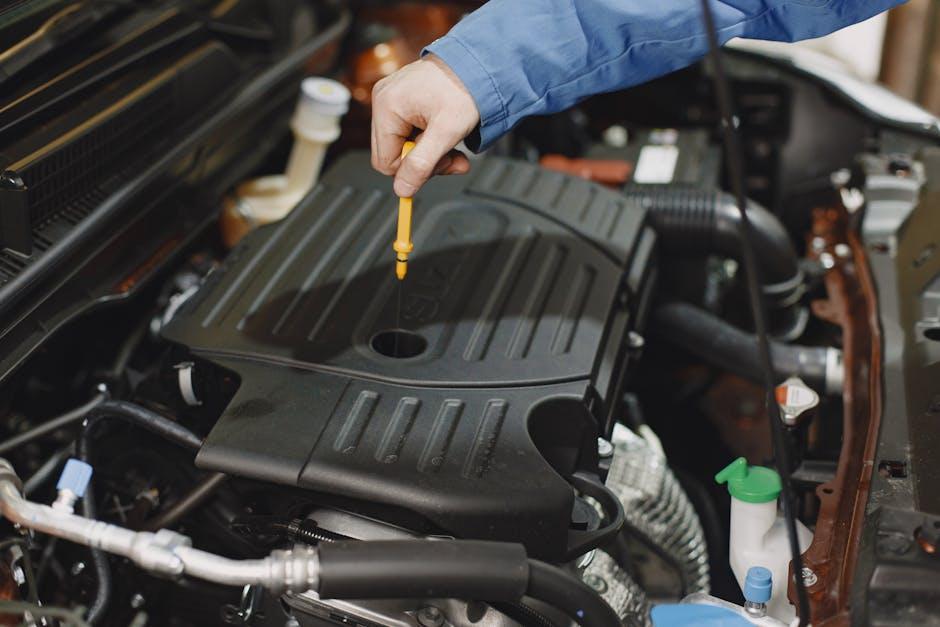Beneath the hood of every vehicle lies a symphony of moving parts, each relying on a thin, golden elixir to keep the engine humming smoothly—engine oil. Checking your engine oil level might seem like a simple task, but it’s a crucial ritual in the dance of vehicle maintenance. Whether you’re a seasoned driver or a curious newcomer, understanding how to accurately check and interpret your engine oil level can save you from unexpected breakdowns and costly repairs. In this guide, we’ll walk you through the essential steps to ensure your engine oil is just right, helping your car perform at its best and extend its lifespan.
Table of Contents
- Choosing the Right Time and Environment for Checking Engine Oil
- Understanding the Dipstick and Its Indicators
- Step-by-Step Guide to Accurately Measuring Oil Level
- Interpreting Oil Level Results and What They Mean
- Common Mistakes to Avoid When Checking Engine Oil
- Knowing When and How to Add Engine Oil Properly
- Q&A
- The Way Forward

Choosing the Right Time and Environment for Checking Engine Oil
For accurate results, it’s best to check your engine oil when the vehicle is parked on a level surface. This ensures the oil settles evenly in the oil pan rather than pooling unevenly, which can lead to incorrect readings. Additionally, the engine should be cool or slightly warm. Checking oil right after driving hot can cause scalding risks and might show a temporarily low level due to oil circulating throughout the engine.
Choosing the right environment also means avoiding dusty or windy locations where dirt could contaminate the dipstick or oil cap when opened. Ideally, perform this task in a well-lit area so you can clearly see the oil’s color and level. To sum it up, here’s a quick checklist:

Understanding the Dipstick and Its Indicators
The dipstick is a simple yet vital tool for monitoring your engine’s health. It allows you to check both the level and condition of your engine oil quickly. When you pull out the dipstick, you’ll notice two key areas: the minimum and maximum marks. The oil level should always sit between these marks—this range ensures there’s enough lubrication for your engine’s moving parts. If the oil is below the minimum mark, it’s a sign that more oil is needed. Conversely, too much oil can also cause problems, like foaming or increased pressure, so maintaining the right balance is crucial.
Besides the level, the dipstick reveals vital clues about the oil’s quality. Here’s what to look for:
- Color: Fresh oil is amber and translucent; dark, opaque oil suggests it’s time for a change.
- Consistency: Smooth oil is good, but gritty or sludge-like texture indicates contamination.
- Smell: A burnt or unusual odor could signal engine issues.
| Dipstick Indicator | Meaning |
|---|---|
| Oil Level between Min & Max | Normal and safe operating range |
| Oil Level below Min | Oil needs to be added |
| Oil Level above Max | Excess oil; risk of engine damage |
| Dark or gritty oil | Oil change recommended |

Step-by-Step Guide to Accurately Measuring Oil Level
Begin by ensuring your engine is cool and parked on level ground to get an accurate reading. Open the hood and locate the oil dipstick — usually marked with a bright handle. Pull the dipstick out and wipe it clean with a lint-free cloth or paper towel to remove old oil residue. Insert the dipstick back fully and then pull it out again to check the oil level. The measurement markings on the dipstick, often labeled with MIN and MAX indicators, will show where the current oil level stands. Avoid guessing if the oil appears too dark or gritty, as this could signal the need for an oil change.
- Check multiple times: Reinsert and remove the dipstick a couple of times for consistency.
- Note the oil color: Healthy oil is amber; very dark or black oil requires attention.
- Refill carefully: Use the recommended oil type for your engine and don’t overfill.
| Oil Level Indicator | Meaning | Recommended Action |
|---|---|---|
| Above MAX | Too Much Oil | Drain some oil to avoid damage |
| Between MIN and MAX | Optimal | No action needed |
| Below MIN | Low oil level | Add oil promptly |
Accuracy during this routine maintenance step can prevent potential engine damage and extend your vehicle’s life. Remember to keep a close eye on the oil level at regular intervals, especially before long trips or after driving in harsh conditions. Keeping a small oil container handy for quick top-ups can save you from inconvenient breakdowns.

Interpreting Oil Level Results and What They Mean
Understanding the results of your engine oil level check goes beyond just spotting whether the oil hits the maximum or minimum marks on the dipstick. If the oil level is too low, it can lead to inadequate lubrication, causing increased friction and potential engine damage. On the other hand, an oil level that’s too high can result in foaming, which reduces its efficiency to lubricate and cool the engine parts properly. It’s essential to maintain the oil within the ideal range to ensure optimal engine performance.
Besides quantity, the quality and appearance of the oil also carry vital information. Look for signs such as:
- Color: Fresh oil is amber, turning darker with use.
- Consistency: Gritty or milky textures can indicate contamination.
- Smell: A burnt odor may point to overheating or engine issues.
The following table summarizes common oil level conditions and their potential meanings:
| Oil Level Condition | Possible Cause | Recommended Action |
|---|---|---|
| Below Minimum | Oil leak or consumption | Top up immediately; inspect for leaks |
| Above Maximum | Overfilled during oil change | Drain excess oil to correct level |
| Within Range | Optimal level | Continue regular monitoring |

Common Mistakes to Avoid When Checking Engine Oil
One of the most frequent errors drivers make is checking the oil right after turning off the engine. The oil needs a few minutes to settle back into the pan for an accurate reading; skipping this step often leads to false reports of low oil levels. Another typical mistake is not using a clean cloth to wipe the dipstick first. Dirt or old oil residue can skew the results, causing unnecessary worry or, worse, neglecting a real issue.
Additionally, many forget to ensure the car is parked on a level surface. An uneven slope can trick your dipstick reading, disguising the true oil condition. It’s also common for people to misread the markings on the dipstick; not all dipsticks have the same level indicators, so it’s essential to familiarize yourself with your vehicle’s specifics. Remember these simple tips to get the most reliable assessment:
- Wait 5-10 minutes after engine shutdown before checking.
- Always clean the dipstick before reinserting it.
- Check oil level with the car on a flat, level surface.
- Consult your owner’s manual to understand dipstick markings.

Knowing When and How to Add Engine Oil Properly
Maintaining the right engine oil level is crucial for the performance and longevity of your vehicle’s engine. Avoid topping up oil immediately after driving, as the engine oil needs time to settle, allowing for an accurate reading. Ideally, check the level when the engine is cold or has been off for at least 10 minutes. This ensures the oil has drained back into the pan and isn’t dispersed in the engine components. When adding oil, use a clean funnel to prevent contaminants from entering, and pour slowly to avoid overfilling. An overfilled engine can cause increased pressure, resulting in leaks or damage to seals.
Here are some helpful pointers for adding engine oil safely and effectively:
- Use the right oil type as specified in your owner’s manual.
- Check oil level frequently, especially before long trips.
- Top up gradually, checking the dipstick after every small addition.
- Never mix different oil brands or grades unless specifically allowed by your vehicle manufacturer.
| Oil Grade | Recommended Temperature |
|---|---|
| 5W-30 | -20°C to 35°C |
| 10W-40 | -10°C to 40°C |
| 15W-50 | 0°C to 45°C |
Q&A
Q&A:
Q1: Why is it important to check the engine oil level regularly?
A1: Engine oil lubricates the moving parts inside your engine, preventing friction and overheating. Regularly checking the oil level ensures your engine runs smoothly and helps avoid costly repairs caused by low or dirty oil.
Q2: When is the best time to check the engine oil level?
A2: For the most accurate reading, check the oil when the engine is off and has cooled down for at least 10 minutes. This allows the oil to settle back into the pan, giving you a true level measurement.
Q3: What tools do I need to check my engine oil?
A3: You only need a clean rag or paper towel and, of course, your car’s dipstick—usually a brightly colored handle located near the engine.
Q4: How do I locate the dipstick in my vehicle?
A4: Open the hood and look for a loop or handle, often yellow or orange. If you’re unsure, consult your owner’s manual for the exact location.
Q5: What are the steps to check the oil level?
A5:
- Park on level ground and turn off the engine.
- Open the hood and remove the dipstick.
- Wipe it clean with a rag or paper towel.
- Reinsert the dipstick fully, then pull it out again.
- Check the oil level against the marked indicators—“Min” and “Max” or two holes/lines.
Q6: What should I do if the oil level is below the minimum mark?
A6: Add the recommended type of engine oil gradually, checking frequently to avoid overfilling. Be sure to consult your owner’s manual or a professional if you’re unsure about the oil type.
Q7: Can I check the oil level right after driving?
A7: It’s best to wait after driving because the oil is hot and distributed throughout the engine. Checking immediately may give a falsely low reading.
Q8: What if the oil looks dirty or contaminated?
A8: Dark or gritty oil suggests it’s time for an oil change. Regular oil changes keep your engine healthy and extend its lifespan.
Q9: How often should I check my engine oil?
A9: Aim to check your oil level at least once a month and before long trips for peace of mind.
Q10: Can a faulty dipstick affect the reading?
A10: Yes, a bent or damaged dipstick can give inaccurate readings. Replace it if you notice any damage to ensure correct maintenance.
Maintaining your engine oil is a simple yet vital habit—think of it as giving your engine a daily vitamin boost!
The Way Forward
Checking your engine oil level may seem like a small task, but it’s a vital ritual that keeps your car’s heart beating smoothly. By taking a few minutes to inspect and maintain the right oil level, you’re not just preserving engine health—you’re investing in reliability, performance, and peace of mind. So next time you pop the hood, remember: a dipstick and a little attention go a long way toward keeping your journey rolling strong.


2 Comments
nbk47y
nbk47y